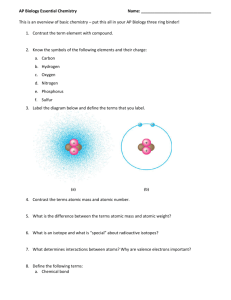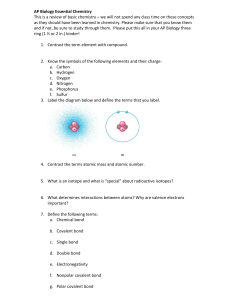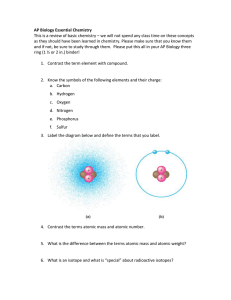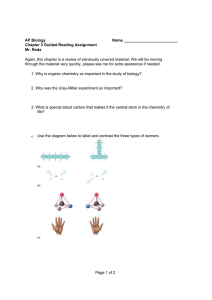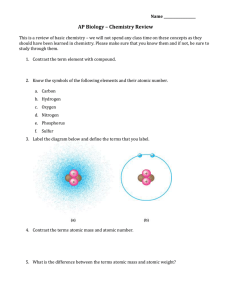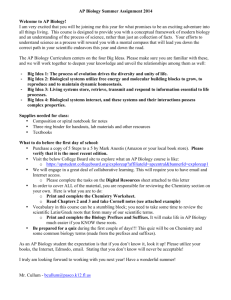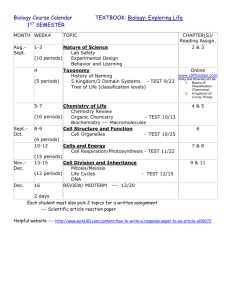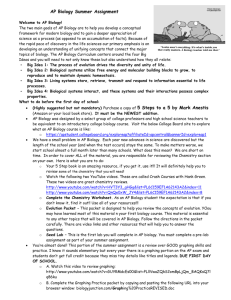Chemistry Worksheet and Scientific Word Origins
advertisement
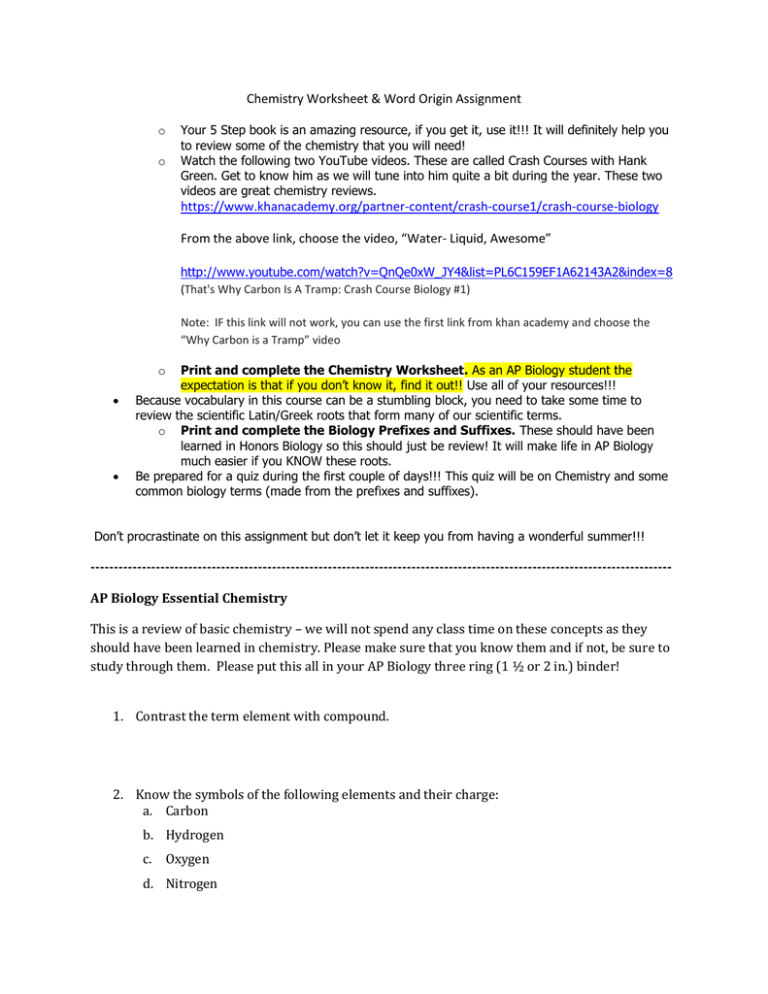
Chemistry Worksheet & Word Origin Assignment o o Your 5 Step book is an amazing resource, if you get it, use it!!! It will definitely help you to review some of the chemistry that you will need! Watch the following two YouTube videos. These are called Crash Courses with Hank Green. Get to know him as we will tune into him quite a bit during the year. These two videos are great chemistry reviews. https://www.khanacademy.org/partner-content/crash-course1/crash-course-biology From the above link, choose the video, “Water- Liquid, Awesome” http://www.youtube.com/watch?v=QnQe0xW_JY4&list=PL6C159EF1A62143A2&index=8 (That's Why Carbon Is A Tramp: Crash Course Biology #1) Note: IF this link will not work, you can use the first link from khan academy and choose the “Why Carbon is a Tramp” video Print and complete the Chemistry Worksheet. As an AP Biology student the expectation is that if you don’t know it, find it out!! Use all of your resources!!! Because vocabulary in this course can be a stumbling block, you need to take some time to review the scientific Latin/Greek roots that form many of our scientific terms. o Print and complete the Biology Prefixes and Suffixes. These should have been learned in Honors Biology so this should just be review! It will make life in AP Biology much easier if you KNOW these roots. Be prepared for a quiz during the first couple of days!!! This quiz will be on Chemistry and some common biology terms (made from the prefixes and suffixes). o Don’t procrastinate on this assignment but don’t let it keep you from having a wonderful summer!!! ----------------------------------------------------------------------------------------------------------------------------AP Biology Essential Chemistry This is a review of basic chemistry – we will not spend any class time on these concepts as they should have been learned in chemistry. Please make sure that you know them and if not, be sure to study through them. Please put this all in your AP Biology three ring (1 ½ or 2 in.) binder! 1. Contrast the term element with compound. 2. Know the symbols of the following elements and their charge: a. Carbon b. Hydrogen c. Oxygen d. Nitrogen e. Phosphorus f. Sulfur 3. Label the diagram below and define the terms that you label. 4. Contrast the terms atomic mass and atomic number. 5. What is the difference between the terms atomic mass and atomic weight? 6. What is an isotope and what is “special” about radioactive isotopes? 7. What determines interactions between atoms? Why are valence electrons important? 8. Define the following terms: a. Chemical bond b. Covalent bond c. Single bond d. Double bond e. Electronegativity f. Nonpolar covalent bond g. Polar covalent bond 9. What is the difference between a structural and molecular formula? 10. Know both the molecular and structural formula for the following compounds. a. Oxygen gas b. Carbon dioxide c. Glucose d. Phosphate e. Ammonia f. Water (you would be surprised at how many people missed this!!!) 11. How do ionic bonds compare with covalent bonds? 12. Compare and contrast hydrogen bonds and van der Waals interactions. 13. Define a dynamic chemical equilibrium in terms of quantities of reactants and products. This is a critical concept! 14. Why is water considered a polar molecule? 15. For each of the below listed properties of water – briefly define the property and then explain how water’s polar nature and polar covalent bonds contribute to the water special property. a. Cohesion b. Adhesion c. Surface tension d. High specific heat e. Heat of vaporization f. Evaporative cooling 16. What is special about water and density? 17. Explain how these properties of water are related to the phenomena described in the statements below. More than one property may be used to explain a given phenomenon. a. During the winter, air temperatures in the northern United States can remain below 0°C for months; however, the fish and other animals living in the lakes survive. b. Many substances—for example, salt (NaCl) and sucrose—dissolve quickly in water. c. When you pour water into a 25-ml graduated cylinder, a meniscus forms at the top of the water column. d. Sweating and the evaporation of sweat from the body surface help reduce a human’s body temperature. e. Water drops that fall on a surface tend to form rounded drops or beads. f. Water drops that fall on your car tend to bead or round up more after you polish (or wax) the car than before you polished it. g. If you touch the edge of a paper towel to a drop of colored water, the water will move up into (or be absorbed by) the towel. 18. Define the following terms: a. Solute b. Solvent c. Aqueous solution d. Hydrophilic e. Hydrophobic f. Molarity 19. MOLARITY A. Concentration – comparison of solute to solvent a. Concentrated – large ratio of solute to solvent b. Dilute – small ratio of solute to solvent ( solute : solvent) B. Molarity – a. Symbol – M b. Equation – in reference table M = moles of solute L of solution Molarity (M) = M= mass molar mass L of solution moles solute liters solution C. Example Problems 1. What is the molarity of a solution formed by mixing 10.0 g of H2SO4 with enough water to make 0.100 L of solution? 3. How many moles of LiBr must be added to .650 L of water to make a 2.0 M solution? 2. To prepare 10.5 L of a 2.50 M solution of KOH, how many grams of potassium hydroxide must be used? 4. What is the molarity of the solution produced when 145 g of NaCl is dissolved in sufficient water to prepare 2.75 L of solution? 5. How many grams of KCl are needed to prepare 0.750 L of a 1.50 M solution? 6. What is the molarity of the solution produced when .594 mol of HCl is dissolved in 0.385 L of water? 7. To produce 3.00 L of a 1.90 M solution of sodium hydroxide, how many grams of NaOH must be dissolved? 8. If 8.77 g of KI are dissolved in enough water to make 4.75 L of solution, what is the molarity of the solution? 20. Label the diagram below to demonstrate the dissociation of the water molecule and then relate this diagram to the term pH. 21. What defines an acid and a base? 22. Why are small changes in pH so important in biology? 23. What is a buffer? Give an example on how they would work in a living organism. 24. What is acid precipitation and why is it important to living organisms? 25. Why is organic chemistry so important in the study of biology? 26. What is special about carbon that makes it the central atom in the chemistry of life? 27. Describe and contrast the three types of isomers. Draw a sketch of each a. Structural – b. Geometric – c. Enantiomers – 28. Be familiar with each of the following functional groups – know it’s chemical compound and the functional properties a. Hydroxyl b. Carbonyl c. Carboxyl d. Amino e. Sulfhydryl f. Phosphate Biology Prefixes and Suffixes-The Language of Science The main reason students find it difficult to understand science is because of all the hard to write, spell and read words. Actually, scientific vocabulary is a mix of small words that are linked together to have different meanings. If you learn the meanings of the little words, you'll find scientific vocabulary much easier to understand. Find the mean to the following Greek/Latin root words. Word Meaning Word a / an hemo meso hyper leuco hypo aero intra anti -itis amphi lateral aqua / hydro -logy arthro -lysis auto -meter bi / di mono bio morph cephal micro chloro macro chromo multi / poly cide pod Meaning cyto -phobia derm -philia haplo proto ecto (exo) photo endo psuedo epi synthesis gastro sub genesis troph herba therm hetero tri homo zoo, zoa ov -tropism kary -taxis neuro -stasis soma zyg / zygous saccharo phago primi / archea path / pathy phyll sym / syn Once you have completed the above table, use it to develop a definition, in your own words, for each of the following terms. 1. Hydrology __________________________________________________________________ 2. Cytolysis _________________________________________________________________ 3. Protozoa______________________________________________________________ _____ 4. Epidermis __________________________________________________________________ 5. Spermatogenesis ___________________________________________________________ 6. exoskeleton____________________________________________________________ ____ 7. Abiotic ____________________________________________________________________ 8. Pathogen _________________________________________________________________ 9. psuedopod ________________________________________________________________ 10. Hemophilia _______________________________________________________________ 11. Endocystosis ______________________________________________________________ 12. herbicide ________________________________________________________________ 13. Anaerobic ________________________________________________________________ 14. Bilateral __________________________________________________________________ 15. autotroph _______________________________________________________________ 16. Monosaccharide __________________________________________________________ 17. Arthropod ________________________________________________________________ 18. polymorphic ______________________________________________________________ 19. Hypothermia ______________________________________________________________ 20. Biogenesis ________________________________________________________________
